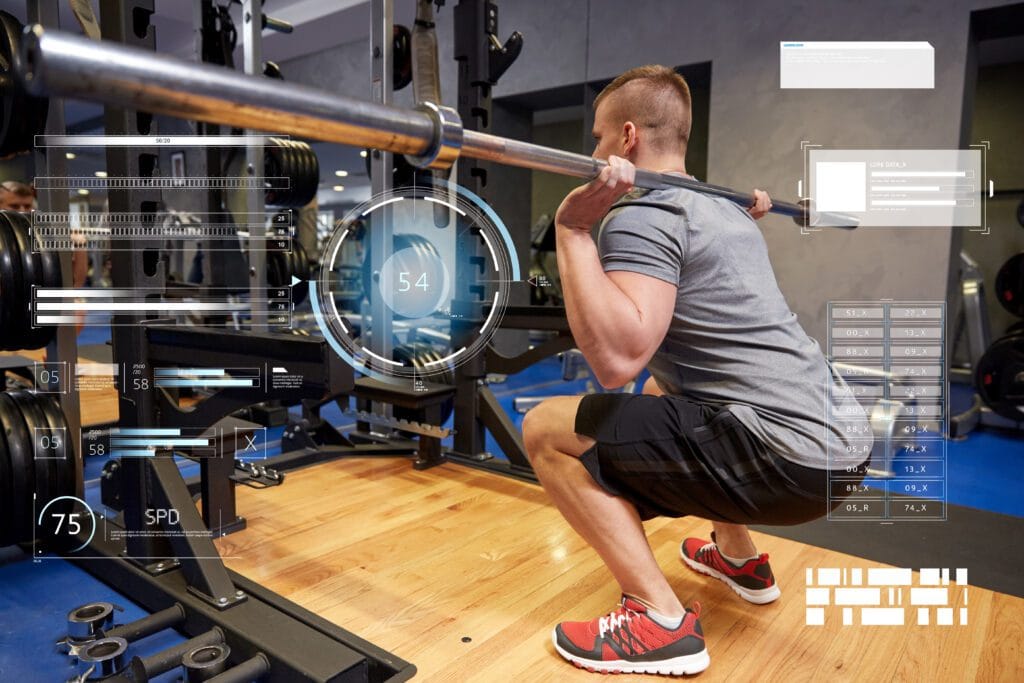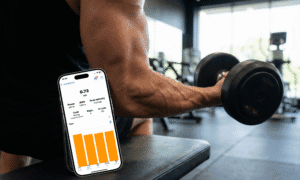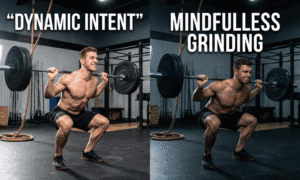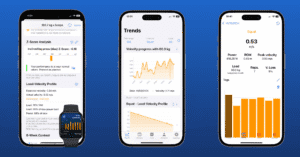If you’ve spent any time in the weight room lately, you’ve probably noticed coaches staring at screens between sets, tracking numbers that go way beyond counting reps and sets. Welcome to the era of velocity-based training—a methodology that’s fundamentally changing how we think about getting stronger, faster, and more powerful.
But here’s the thing: VBT isn’t just another fitness fad destined to disappear when the next shiny object comes along. It’s a scientifically-backed approach that addresses some of the most persistent problems in resistance training. The question isn’t whether you should be paying attention to velocity—it’s why you’d train any other way.
DOWNLOAD SPLEEFT APP NOW FOR iOS, ANDROID AND APPLE WATCH!
The Problem with Traditional Training (And Why We All Pretend It’s Fine)
Let’s be honest about traditional percentage-based training for a second. You test your one-rep max, calculate percentages, write them down in your program, and then… what? You follow those same percentages for weeks or months, ignoring the fact that your body doesn’t work on a spreadsheet schedule.
Monday morning after a terrible night’s sleep? You’re still lifting 85% of your 1RM because that’s what the program says. Coming off a brutal week of competitions or training? Same weights. Feeling absolutely dialed in and ready to crush it? You’re still stuck lifting the predetermined load.
Why is velocity based training important? Because it solves this fundamental disconnect between what your program says you should lift and what your body can actually handle on any given day. Traditional methods assume your strength is constant—VBT acknowledges the reality that your neuromuscular system fluctuates daily, sometimes by as much as 18%¹²’¹³’¹⁶’²⁹.
The Science Behind the Velocity
Here’s where things get interesting. The relationship between load and velocity follows a remarkably consistent pattern: the heavier the weight, the slower you move it. This inverse relationship isn’t just observable—it’s predictable²’²⁵’²⁷.
When you squat 50% of your max, the bar moves at a certain velocity. Bump it up to 70%, and the velocity drops proportionally. This load-velocity relationship is so stable that researchers can use it to predict your 1RM without ever testing it²’²⁵. No grinding reps. No injury risk from maxing out. Just objective data from submaximal lifts.
But velocity tells us more than just how heavy the weight is. Movement velocity is intimately connected to neuromuscular fatigue⁴’¹⁵’¹⁶. As fatigue accumulates during a set, bar velocity decreases—your nervous system literally can’t fire fast enough to maintain the same velocity. This velocity loss becomes a window into your fatigue state, something traditional training methods completely miss.
Studies have shown that monitoring velocity during warm-ups can assess daily readiness with remarkable accuracy²⁷’²⁹. If your typical warm-up velocity is 10% lower than your recent average, that’s an objective red flag that you need to adjust your training for the day¹.
Practical Uses of Velocity Based Training: Beyond the Numbers

The beauty of VBT lies in its versatility. It’s not a one-trick pony—it’s an entire stable of training applications.
1. Autoregulation That Actually Works
Imagine your training program could adapt to you instead of forcing you to adapt to it. That’s autoregulation, and VBT makes it objective rather than subjective⁶’⁷.
Using velocity thresholds, you can set training targets based on current performance rather than predetermined loads. If your velocity on a given exercise is higher than expected, you can confidently add weight. If it’s sluggish, you scale back. The data removes the guesswork¹’⁶.
Research comparing VBT with traditional methods found that athletes using velocity-based autoregulation experienced less accumulated fatigue while achieving similar or superior strength gains⁸’⁹’²². The key insight? You don’t need to constantly push to failure to get stronger—you need to train at the right intensity for your current state⁴’⁵.
2. Fatigue Management and Injury Prevention
This is where VBT becomes genuinely invaluable, especially for athletes managing multiple training stressors. By tracking velocity loss within sets, coaches can control fatigue accumulation with surgical precision⁴’⁵.
Studies have established clear guidelines: velocity losses of 10-20% per set optimize neuromuscular adaptations and power development without excessive fatigue⁵’¹⁴. Push beyond 30-40% velocity loss, and you’re generating more fatigue than necessary for the adaptation you’re chasing⁵.
For injury prevention, VBT provides early warning signs before form breaks down or compensatory patterns emerge. When velocity drops precipitously, it’s your nervous system waving a white flag—and VBT lets you see it in real-time¹’⁶.
3. Individualized Training Zones
Not all athletes are created equal. Some are naturally more forceful, grinding through heavy loads with determination. Others are velocity-dominant, excelling at lighter loads moved explosively. Traditional percentage-based programs treat everyone the same. VBT doesn’t³’¹⁰.
By creating individual load-velocity profiles for each athlete, coaches can identify specific strengths and weaknesses across the force-velocity spectrum³’¹⁰. An athlete who’s relatively weak at high velocities might need more velocity-strength work, while someone struggling at lower velocities requires maximum strength development.
The research is clear: training programs optimized based on individual force-velocity profiles produce superior adaptations compared to generic percentage-based approaches⁸’³⁰. One study found that low velocity-loss training (maintaining high bar velocities) improved jump performance and sprint velocity more effectively than traditional training, despite using less total volume⁵’⁸.
4. Real-Time Feedback and Motivation
Here’s something that doesn’t get enough attention: VBT fundamentally changes the training environment. When athletes can see their velocity on every rep, training becomes more engaging, competitive, and accountable¹¹’²⁹.
Studies examining feedback mechanisms found that athletes receiving real-time velocity data showed improved movement intent, better focus, and greater training motivation¹¹. The immediate feedback creates a gamified environment where athletes compete not just against the weight, but against their previous velocities⁶’¹¹.
For team sports settings with large squads, this is a game-changer. Instead of athletes going through the motions, they’re actively engaged, trying to beat their numbers or their teammates’ scores. The competition drives intensity without requiring coaches to stand over everyone constantly²⁹.
5. Load Prescription Without 1RM Testing
Testing true 1RMs is time-consuming, fatiguing, and carries injury risk. VBT eliminates the need for it entirely while providing more nuanced information²’²⁵.
By establishing a load-velocity profile using submaximal loads (typically 40-90% of estimated max), coaches can predict 1RM with high accuracy²’²⁵. More importantly, they can prescribe training loads based on target velocities rather than percentages, ensuring athletes always train at the intended intensity regardless of daily fluctuations³’⁶.
This approach is particularly valuable during in-season training or rehabilitation, where testing maximal loads is inappropriate¹’⁶. Athletes can still train optimally without the risks associated with max testing.
The Evidence: VBT vs. Traditional Training
The research comparing velocity-based training with percentage-based training tells a compelling story. Multiple meta-analyses have examined this question, and the findings consistently favor VBT—especially for athletes in competitive seasons¹²’¹³’¹⁷’²².
A systematic review published in PLOS ONE found that while both VBT and traditional training improved strength, VBT achieved these gains with notably less training volume and reduced perceived training stress¹². Athletes weren’t just getting stronger—they were doing it more efficiently.
Another meta-analysis examining strength, jump, and sprint performance found that velocity-loss-based training approaches ranked at the top for all three outcomes¹³’²³. Low velocity loss protocols (10-20%) were particularly effective for explosive performance, while still producing significant strength gains⁵’¹⁴.
Perhaps most compelling is the research on training efficiency. Studies found that VBT programs allowed athletes to accumulate less fatigue while maintaining or exceeding the performance improvements of traditional training⁸’¹⁷’²². The implications for in-season training, where fatigue management is critical, are profound.
Why Velocity Based Training Matters for Your Training
Let’s get practical for a moment. Whether you’re a strength coach working with a team, a personal trainer with individual clients, or an athlete training yourself, why is velocity based training important boils down to a few non-negotiable realities:
You can’t optimize what you don’t measure. Traditional training relies on subjective assessments—how you feel, how the weight felt, whether you could have done more reps. VBT provides objective data that removes the guesswork²’⁶.
Daily readiness varies wildly. Sleep quality, stress levels, nutrition, previous training, competition demands—all of these factors influence your neuromuscular system’s capacity on any given day. VBT accounts for this variability automatically¹’²⁹.
Not all fatigue is created equal. A set that leaves you five reps from failure creates different adaptations than a set taken to complete failure. VBT lets you control exactly how much fatigue you’re generating, matching it precisely to your training goals⁴’⁵.
Motivation matters. Athletes who receive immediate, objective feedback on their performance stay more engaged, work harder, and get better results¹¹’²⁹. The competitive element of VBT creates intensity that’s difficult to replicate with traditional methods.
Implementing VBT: The Practical Reality
Here’s where many coaches get overwhelmed. The science is compelling, but implementation seems daunting. Do you need expensive equipment? Complex spreadsheets? A PhD in biomechanics?
The truth is, modern VBT technology has evolved dramatically. What once required $3,000+ linear position transducers now fits in your pocket. Apps like Spleeft have democratized velocity-based training, providing accurate, real-time velocity measurement using just your iPhone, iPad, or Apple Watch.
With Spleeft, you’re getting research-grade accuracy (correlation >0.95 with laboratory equipment) without the laboratory price tag. The app tracks barbell velocity and jump height directly from your wrist or phone, integrates with training platforms like TrainingPeaks, and allows coaches to manage unlimited athletes from anywhere.
The beauty of Spleeft’s approach is its accessibility. You don’t need to completely overhaul your training methodology overnight. Start simple:
Week 1-2: Just measure. Track velocity on your main lifts during warm-ups and working sets. Get familiar with what different velocities feel like.
Week 3-4: Set velocity targets. If you’re training for maximum strength, aim for 0.3-0.5 m/s. For velocity-strength, target 0.75-1.0 m/s. For explosive power, go above 1.3 m/s³’⁶.
Week 5-6: Implement velocity loss thresholds. Stop your sets when velocity drops 15-20% from your first rep. Notice how this changes your training stress and recovery⁴’⁵.
Week 7+: Build load-velocity profiles. Test your athletes across a range of loads and create individualized training zones²’³.
The progression is manageable, and the insights you gain at each stage immediately improve your training.
Practical Uses of Velocity Based Training Across Different Sports
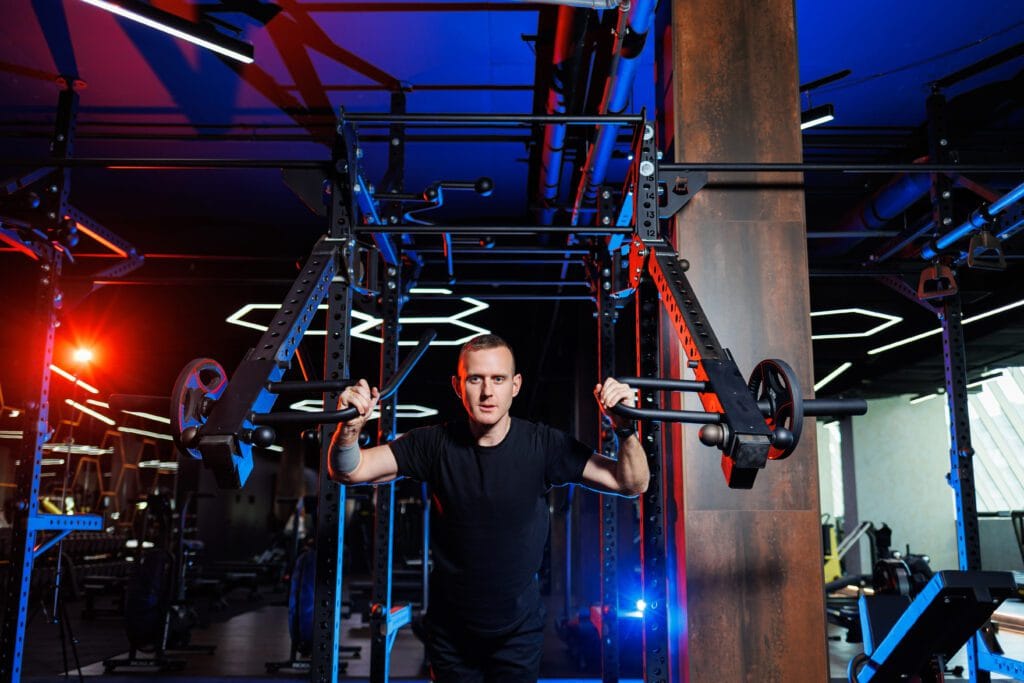
The versatility of VBT becomes apparent when you see how different sports apply it:
Team Sports (soccer, basketball, rugby): Coaches use VBT to manage fatigue across congested competition schedules. By monitoring velocity during in-season strength sessions, they can ensure players are maintaining qualities without accumulating excessive fatigue that would impair game-day performance¹’²⁹.
Combat Sports (boxing, MMA): The emphasis is on explosive power and rate of force development. VBT helps fighters train for the rapid force production required in striking while managing the considerable fatigue from technical and conditioning work³’⁶.
Track and Field: Sprinters and jumpers use VBT to optimize their position on the force-velocity curve, ensuring they’re developing both the force and velocity capacities needed for maximum performance¹⁸’¹⁹.
Strength Sports (powerlifting, weightlifting): Even in sports where maximum strength is paramount, VBT helps athletes manage training intensity, prevent overtraining, and track progress without constant 1RM testing²⁰’²¹.
The Future Is Measured in Meters Per Second
We’re at an inflection point in strength and conditioning. The old model of training—based on static percentages and subjective assessments—is giving way to dynamic, individualized, data-driven approaches that actually account for the realities of human physiology.
Why is velocity based training important? Because it represents the fundamental shift from training based on what you should be able to lift to training based on what you can lift today. It’s the difference between forcing your body to match a program and creating a program that matches your body.
The research is overwhelming. The technology is accessible. The applications span every training goal from maximum strength to explosive power. The question isn’t whether VBT should be part of modern training—it’s whether you can afford to keep training without it.
For coaches and athletes ready to take their training to the next level, tools like Spleeft App make implementing velocity-based training straightforward and effective. With accurate measurements, real-time feedback, and comprehensive athlete management features, you can start applying VBT principles immediately—no expensive equipment or complex systems required.
The strength and conditioning world moves forward. The only question is whether you’re moving with it or getting left behind with your outdated percentage calculators. Your athletes—and your results—deserve better than guesswork. They deserve velocity.
Frequently Asked Questions
What equipment do I need to start velocity-based training?
While traditional VBT setups required expensive linear position transducers costing $3,000+, modern solutions have made the technology much more accessible. You can start with smartphone apps like Spleeft that use your iPhone or Apple Watch to measure velocity with research-grade accuracy. Other options include dedicated VBT devices like GymAware, Vitruve encoders, or inertial measurement units like the Output Sports sensor.
How accurate are smartphone-based VBT apps compared to expensive equipment?
High-quality smartphone apps like Spleeft have shown excellent correlation (>0.95) with laboratory-grade equipment when properly validated²⁴. While dedicated hardware may offer slightly higher precision in certain conditions, smartphone-based solutions provide more than adequate accuracy for practical training applications and are significantly more cost-effective.
Can beginners use velocity-based training, or is it only for advanced athletes?
VBT is actually extremely valuable for beginners because it teaches proper training intent and movement quality from day one. Novice lifters often don’t understand what “explosive” or “maximal effort” means, but giving them a velocity target (like 0.75 m/s for a squat) provides immediate, objective feedback. The real-time data helps beginners learn to move weights with appropriate velocity and intent¹¹.
How do I determine my personal load-velocity profile?
Start with a systematic testing protocol using loads from 40-90% of your estimated 1RM. Perform 2-3 reps at each load (40%, 50%, 60%, 70%, 80%, 90%) with full recovery between sets. Record the average velocity for each load and plot the relationship. This creates your individual profile, which should be retested every 6-8 weeks as strength improves².
What’s the difference between mean velocity and peak velocity?
Mean velocity measures the average velocity throughout the entire range of motion, while peak velocity captures the fastest point during the lift (usually early in the concentric phase). Mean velocity is generally preferred for VBT applications because it’s more stable, reproducible, and better represents the overall effort of the lift²⁴’²⁶.
How often should I retest my load-velocity profile?
For most athletes, retesting every 6-8 weeks is sufficient. However, during periods of rapid strength gains (like with beginners) or after significant training changes, you may need to retest every 4 weeks. Advanced athletes with slower strength progressions might only need testing every 10-12 weeks²’²⁶.
Can I use VBT for bodybuilding and hypertrophy training?
Absolutely. VBT can optimize hypertrophy training by controlling velocity loss thresholds. For muscle growth, moderate velocity losses of 30-40% per set may be appropriate, as they ensure sufficient mechanical tension and metabolic stress. However, if training explosive athletes who need hypertrophy, limiting velocity loss to 15-20% maintains the fast-twitch characteristics while still promoting muscle growth⁵.
What velocity zones should I use for different training goals?
Based on Dr. Bryan Mann’s force-velocity spectrum: Starting Strength (>1.3 m/s, 0-25% 1RM), Velocity Strength (1.0-1.3 m/s, 25-45% 1RM), Strength Velocity (0.75-1.0 m/s, 45-65% 1RM), Accelerative Strength (0.5-0.75 m/s, 65-85% 1RM), and Absolute Strength (<0.5 m/s, >85% 1RM)³. These zones help target specific adaptations based on your sport and training phase.
How do I use VBT during in-season training?
During competitive seasons, VBT becomes crucial for managing fatigue while maintaining strength. Use daily readiness assessments with a standard warm-up load—if velocity drops 10% below normal, reduce training volume and intensity. Focus on maintaining velocities above 0.5 m/s to preserve power characteristics while avoiding excessive fatigue accumulation¹’²⁹.
What’s the best way to implement VBT with a large team?
Start with group profiling sessions where all athletes perform the same protocol. Use velocity targets rather than percentages for programming (e.g., “squat until velocity drops below 0.6 m/s”). Implement partner systems where athletes monitor each other’s velocities. Modern apps like Spleeft allow coaches to manage unlimited athlete profiles and track progress remotely, making team implementation much easier.
How does VBT help prevent overtraining?
VBT provides objective markers of neuromuscular fatigue before subjective symptoms appear. Daily readiness monitoring through velocity tracking can identify athletes at risk of overreaching 3-5 days before traditional markers. When combined with appropriate recovery protocols, this early warning system helps prevent full overtraining syndrome¹’⁶’²⁹.
Can I combine VBT with other training methods like RPE or HRV?
VBT complements other monitoring tools excellently. Use HRV for general recovery status, RPE for subjective load monitoring, and VBT for specific neuromuscular readiness. This multi-modal approach provides the most comprehensive picture of athlete status and allows for more precise training adjustments⁶.
References
González-Badillo, J.J. & Sánchez-Medina, L. (2010). “Movement Velocity as a Measure of Loading Intensity in Resistance Training.” International Journal of Sports Medicine, 31(5):347-352.
Banyard, H. et al. (2017). “Reliability and Validity of the Load-Velocity Relationship to Predict the 1RM Back Squat.” Journal of Strength and Conditioning Research, 31(7):1897-1904.
Mann, J.B., Ivey, P.A., & Sayers, S.P. (2015). “Velocity-Based Training in Football.” Strength and Conditioning Journal, 37(6):52-57.
Sánchez-Medina, L. & González-Badillo, J.J. (2011). “Velocity Loss as an Indicator of Neuromuscular Fatigue During Resistance Training.” Medicine & Science in Sports & Exercise, 43(9):1725-1734.
Pareja-Blanco, F. et al. (2017). “Effects of Velocity Loss During Resistance Training on Athletic Performance, Strength Gains and Muscle Adaptations.” Scandinavian Journal of Medicine & Science in Sports, 27(7):724-735.
Jovanovic, M. & Flanagan, E.P. (2014). “Researched Applications of Velocity Based Strength Training.” Journal of Australian Strength and Conditioning, 22(2):58-69.
Orange, S.T. et al. (2020). “Validity and Reliability of a Wearable Inertial Sensor to Measure Velocity and Power in the Back Squat and Bench Press.” Journal of Strength and Conditioning Research, 34(9):2452-2460.
Banyard, H. et al. (2019). “Superior Changes in Jump, Sprint, and Change-of-Direction Performance but Not Maximal Strength Following 6 Weeks of Velocity-Based Training Compared With 1RM-Percentage-Based Training.” International Journal of Sports Physiology and Performance, 14(7):1-9.
Dorrell, H.F., Smith, M.F., & Gee, T.I. (2020). “Comparison of Velocity-Based and Traditional Percentage-Based Loading Methods on Maximal Strength and Power Adaptations.” Journal of Strength and Conditioning Research, 34(1):46-53.
García-Ramos, A. et al. (2018). “Differences in the Load–Velocity Profile Between 4 Bench Press Variants.” International Journal of Sports Physiology and Performance, 13(3):326-331.
Randell, A.D. et al. (2011). “Effect of Instantaneous Performance Feedback During 6 Weeks of Velocity-Based Resistance Training on Sport-Specific Performance Tests.” Journal of Strength and Conditioning Research, 25(1):87-93.
Liao, K.F. et al. (2021). “Effects of Velocity Based Training vs. Traditional 1RM Percentage-Based Training on Improving Strength, Jump, Linear Sprint and Change of Direction Speed Performance: A Systematic Review with Meta-Analysis.” PLOS ONE, 16(11):e0259790.
Orange, S.T. et al. (2022). The Effectiveness of Traditional vs. Velocity-Based Strength Training on Explosive and Maximal Strength Performance: A Network Meta-Analysis.” Frontiers in Physiology, 13:926972.
Włodarczyk, M. et al. (2021). “Effects of Velocity-Based Training on Strength and Power in Elite Athletes—A Systematic Review.” International Journal of Environmental Research and Public Health, 18(10):5257.
Zhang, X. et al. (2023). “The Effect of Velocity Loss on Strength Development and Related Training Efficiency: A Dose–Response Meta–Analysis.” International Journal of Sports Physiology and Performance, 18(2):230-239.
González-Badillo, J.J. et al. (2017). “The Importance of Movement Velocity as a Measure to Control Resistance Training Intensity.” Journal of Human Kinetics, 29:15-19.
Held, S. et al. (2021). “Improved Strength and Recovery After Velocity-Based Training: A Randomized Controlled Trial.” Applied Sciences, 11(14):6479.
Jiménez-Reyes, P. et al. (2017). “Effectiveness of an Individualized Training Based on Force-Velocity Profiling During Jumping.” Frontiers in Physiology, 7:677.
Morin, J.B. & Samozino, P. (2016). “Interpreting Power-Force-Velocity Profiles for Individualized and Specific Training.” International Journal of Sports Physiology and Performance, 11(2):267-272.
Weakley, J. et al. (2019). “The Validity and Reliability of Commercially Available Resistance Training Monitoring Devices: A Systematic Review.” Sports Medicine, 49(6):833-845.
Thompson, S.W. et al. (2023). “The Perceptions and Applications of Velocity-Based Training Within Elite Strength and Conditioning.” International Journal of Sports Science & Coaching, 18(5):1557-1568.
Pareja-Blanco, F. et al. (2020). “Effects of Velocity Loss in the Bench Press Exercise on Strength Gains, Neuromuscular Adaptations, and Muscle Hypertrophy.” Scandinavian Journal of Medicine & Science in Sports, 30(11):2175-2186.
Weakley, J. et al. (2022). The Effectiveness of Traditional vs. Velocity-Based Strength Training on Explosive and Maximal Strength Performance: A Network Meta-Analysis.” Frontiers in Physiology, 13:926972.
Balsalobre-Fernández, C. et al. (2017). “Validity and Reliability of a Novel iPhone App for the Measurement of Barbell Velocity and 1RM on the Bench-Press Exercise.” Journal of Sports Sciences, 36(1):64-70.
Banyard, H. et al. (2018). “The Reliability of Individualized Load–Velocity Profiles.” International Journal of Sports Physiology and Performance, 13(6):763-769.
Martínez-Cava, A. et al. (2019). “Reliability of Technologies to Measure the Barbell Velocity: Implications for Monitoring Resistance Training.” PLOS ONE, 14(6):e0218738.
Sánchez-Medina, L. et al. (2017). “Velocity- and Power-Load Relationships of the Bench Pull vs. Bench Press Exercises.” International Journal of Sports Medicine, 38(14):1046-1055.
Sekulović, V. et al. (2024). “Effects of Velocity-Based Resistance Training on Young Soccer Players of Different Ages.” Journal of Sports Medicine and Physical Fitness, 64(3):342-350.
Conceição, F. et al. (2016). “Movement Velocity as a Measure of Exercise Intensity in Three Lower Limb Exercises.” Journal of Sports Sciences, 34(12):1099-1106.
Dorrell, H.F. et al. (2019). “Comparison of Individual and Group-Based Load-Velocity Profiling as a Means to Dictate Training Load Over a 6-Week Strength and Power Intervention.” Journal of Sports Sciences, 37(23):2713-2726.
Iván de Lucas Rogero
MSC Physical Performance & CEO SpleeftApp
Dedicated to improving athletic performance and cycling training, combining science and technology to drive results.

